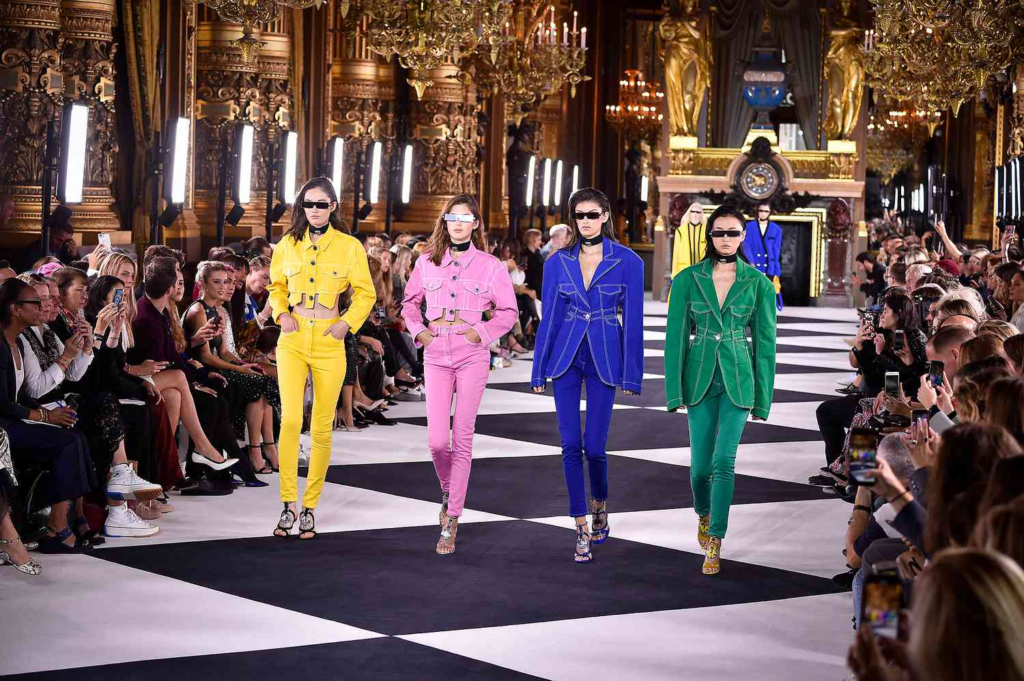Fashion Weeks are more than mere events; they are a confluence of artistry, commerce, and cultural significance. The anticipatory atmosphere, the resplendent displays of creativity, and the potential business collaborations mark the importance of these events in the global fashion calendar.
Unraveling the ‘Big Four’
The principal fashion weeks of New York, London, Milan, and Paris are colossal events. They not only influence global fashion trends but also dictate the business trajectory of the industry for the coming seasons. Cities are abuzz with celebrities, designers, media personalities, and influencers, all of whom play a pivotal role in fashion dissemination.
Key Collections Defined
From ‘Ready-to-Wear’ staples to the opulent world of ‘Haute Couture’, different collections cater to varied audiences. While prêt-à-porter is about accessibility and widespread appeal, haute couture is an ode to exclusivity, craftsmanship, and personalized luxury. Menswear, on the other hand, has evolved immensely, breaking stereotypes and embracing fluidity.
International Fashion Spectacles
Beyond the ‘Big Four’, cities like Tokyo and Melbourne are carving a niche with their unique sartorial contributions. These events highlight the local culture, art, and design ethos, giving global visibility to native designers and local fashion aesthetics.
Specialty Fashion Shows
Beyond general fashion, there are specialized events. Bridal weeks, for instance, spotlight the fantasy and craftsmanship behind wedding couture. Similarly, the Miami Swim Week is a testament to the innovation and creativity in beachwear and swim fashion.
The Impact of Digital Media on Fashion Weeks
Digitalization has transformed traditional runway shows. With the advent of virtual runways, augmented reality fittings, and live-streaming, fashion weeks are now accessible to a global audience. This digital shift democratizes fashion, allowing instantaneous global reach and influencing purchase behaviors.
Evolution and Historical Timeline of Fashion Weeks
Tracing back to the 1940s, fashion weeks have a rich history. What started as small gatherings in fashion salons has now transformed into a global phenomenon. Over the decades, these events have mirrored sociocultural shifts, economic trends, and technological advancements.
The Commercial Significance of Fashion Weeks
Fashion weeks aren’t just artistic showcases; they’re business catalysts. Brand collaborations, retail tie-ups, and media coverage ensure that these events have tangible commercial outcomes. They influence consumer trends, retail purchasing decisions, and even stock market valuations of fashion companies.
Eco-Friendly Trends in Fashion Weeks
Sustainability is the buzzword in contemporary fashion. Many fashion weeks now incorporate eco-friendly practices, promote sustainable brands, and emphasize ethical fashion. From materials to manufacturing processes, the focus is on minimizing the environmental footprint.
Comparative Table: Fashion Weeks Around the World
| City | Primary Focus | Notable Designers | Time of Year |
|---|---|---|---|
| New York | Ready-to-Wear | Calvin Klein | Feb & Sept |
| London | Avant-garde | Alexander McQueen | Feb & Sept |
| Milan | Luxury | Versace | Feb & Sept |
| Paris | Couture | Chanel | Jan & July |
| Tokyo | Innovation | Issey Miyake | Multiple |
| Melbourne | Resort Wear | Zimmermann | Varies |
This table provides a concise comparison, highlighting the unique essence of each fashion week and its global significance.
The Interplay between Fashion, Technology, and Sustainability
The 21st century has seen an unprecedented blend of fashion, technology, and the urgent need for sustainability. As fashion weeks evolve, so too does the industry’s approach to these pivotal areas. This symbiotic relationship is shaping the future of fashion. Here’s a look:
- Smart Fabrics:
- Breathable materials that adjust according to body temperature;
- Fabrics that change color depending on external factors, like mood or light;
- Materials that incorporate mini-sensors to monitor health metrics.
- Virtual Reality (VR) and Augmented Reality (AR) in Shopping:
- Virtual try-ons to reduce the need for physical trial rooms;
- AR apps that overlay accessories on users for an immersive shopping experience;
- VR fashion shows, offering front-row experiences from the comfort of home.
- Sustainable Practices:
- Biodegradable materials replacing harmful synthetics;
- Zero-waste pattern making to ensure minimal material wastage during production;
- Closed-loop manufacturing processes, where end-of-life garments are recycled into new ones.
- 3D Printing in Fashion:
- Bespoke footwear and accessories crafted using 3D printing;
- Potential to revolutionize ‘made-to-order’ clothing, minimizing waste;
- Experimentation with various bioplastics, ensuring eco-friendliness.
- Blockchain for Transparency:
- Traceable supply chains, ensuring ethical practices throughout;
- Verification of authentic materials and ethically-produced items;
- Providing consumers with detailed insights about the origin and journey of their purchased products.
This dynamic fusion of fashion, tech, and eco-consciousness is not just a trend but a testament to the industry’s evolution. These developments not only cater to the modern consumer’s demands but also pave the way for a responsible and innovative future in fashion.

Video Guide
If you still have questions, we suggest you watch the video we have prepared for you. Enjoy watching it!
The Influence of Global Culture on Fashion Trends
As the world becomes more interconnected, the lines between different cultures blur, creating a globalized tapestry of fashion inspiration. This interplay between diverse traditions, aesthetics, and histories results in a rich mosaic of fashion expressions.
- Cultural Crossovers:
- The kimono-inspired trench coats and saree-draped gowns are perfect examples of East meets West;
- African prints finding their way into European summer collections;
- The Bohemian trend, heavily borrowing from Romani traditions.
- Indigenous Inspirations:
- Native American beadwork and patterns appearing in high-fashion accessories;
- Australian Aboriginal dot paintings inspiring print patterns in dresses and skirts;
- Maori tattoo designs influencing graphic t-shirt prints and accessories.
- Historical Reverence:
- Renaissance ruffles and corsets making a comeback in modern-day dresses;
- 1920s flapper dresses being reinvented for the contemporary party scene;
- Ancient Egyptian collars and motifs appearing in couture collections.
As fashion designers and enthusiasts draw from a global pool of inspiration, it’s essential to approach cultural inspirations with sensitivity and respect, avoiding appropriation and instead aiming for genuine appreciation.
Conclusion
Fashion, at its core, reflects the society and times we live in. Today, as our world becomes more intertwined than ever, the realm of fashion serves as a mirror, reflecting the beautiful amalgamation of various cultures, technologies, and sustainable initiatives. While fashion weeks around the world showcase the latest designs and innovations, they also tell stories – stories of heritage, evolution, and visions for the future. As consumers, observers, and aficionados, our role goes beyond mere appreciation. It extends to understanding the depth, the narratives, and the responsibilities that come with fashion. Embracing the future of fashion means not only being stylish but also being informed, inclusive, and sustainable.








+ There are no comments
Add yours